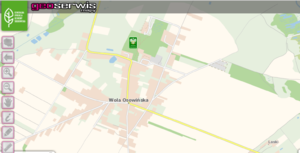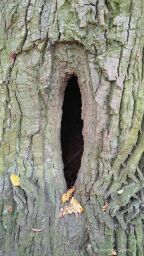Użytkownik:Wolatechnikum/Dewajtis in Wola Osowinska: Różnice pomiędzy wersjami
mNie podano opisu zmian |
mNie podano opisu zmian |
||
| Linia 46: | Linia 46: | ||
== Focal point of the community and turist attraction == | == Focal point of the community and turist attraction == | ||
Dewajtis | The oak Dewajtis has been a landmark of Wola Osowinska. It is visited by the locals, tourists and nature enthusiasts. It serves as a gathering place for community events and cultural activities<ref>[https://gokisborki.pl/europejskie-dni-dziedzictwa/ GOKiS Borki. ''Pod zielonym dębem''. Retrieved 30 May 2024.]</ref><ref>[http://zsr.powiatradzynski.pl/galerie/2023_06_01_dd/album/index.html#20230601_120736.jpg Zespół Szkół Rolniczych w Woli Osowińskiej. ''Fotorelacja z gry terenowej podczas Dnia Dziecka 2023''. Retrieved 30 May 2024.]</ref>. | ||
[[Plik:Students of Wincenty Witos Technical Secondary School in Wola Osowińska1.jpg|alt=The students of Wincenty Witos Technical Secondary School in Wola Osowińska measuring the trunk circumference of Dewajtis|mały|The students of Wincenty Witos Technical Secondary School in Wola Osowińska measuring the trunk circumference of Dewajtis]] | [[Plik:Students of Wincenty Witos Technical Secondary School in Wola Osowińska1.jpg|alt=The students of Wincenty Witos Technical Secondary School in Wola Osowińska measuring the trunk circumference of Dewajtis|mały|The students of Wincenty Witos Technical Secondary School in Wola Osowińska measuring the trunk circumference of Dewajtis]] | ||
Wersja z 21:42, 1 cze 2024
Dewajtis - a pedunculate oak (Quercus robur) located in Wola Osowinska, Poland. It is over 500 years old[1] with a circumference of over 6 meters[2]. It is a natural monument[3] and one of the largest oaks in Radzyn Podlaski County in terms of trunk circumference[4].



Geographical Location
The oak tree Dewajtis grows in the park in the northern part of the village called Wola Osowinska, Poland. The village lies within the administrative district of Gmina Borki, in Radzyn Podlaski County, within the Lublin Voivodeship in eastern Poland.
| Geographical Location | Name/Descripion |
|---|---|
| Country: | Poland |
| Voivodeship: | Lublin |
| County: | Radzyn Podlaski |
| Gmina (Administrative District): | Borki |
| Village: | Wola Osowinska |
| Proximity to Major Cities: | It is situated approximately 16 kilometers southwest of Radzyn Podlaski, the county seat, and about 66 kilometers north of Lublin, the regional capital. |
| Plot numer[5]: | 645/1 |
| Coordinates: | 51.73486, 22.46560 |

Characteristics
- Age: The oak Dewajtis is estimated to be several hundred years old. The exact date of planting is unknown. An accurate count is impossible as Dewajtis' interior has hollowed with age. Before World War II it had been estimated to be 450 years old[6]. Some sources state it is over 500 years old[2][1].
- Dimensions: The avaliable data concerning Dewajtis' dimensions goes back to 1987. At that time the height of the tree was 28 m. The trunk diameter at breast height was 188 cm and its circumference was 591 cm[7]. Current tree measurements show that the circumference is between 640-680 cm[2].
- Appearance: Dewajtis is a monumental oak with a single-stemmed hollow trunk. The boughs and branches of the tree are large and spread out vertically. The leaves are around 7-14 cm long and 4-8 cm wide, with a bright green color in the spring and summer that turns to brown in the autumn.The crown is irregularly shaped. The bark is thick and the trunk has a rugged, textured surface with natural grooves and knots. The bole shows signs of age, with cracks and gnarls.
- Name: The name "Dewajtis" comes from ancient Slavic beliefs. In Lithuanian language a word root "dev" ("diev") means "god"[8]. According to some sources "Dievaitis" belonged to the pantheon of deities worshipped by Baltic peoples[9]. In Lithuanian mythology (as part of the Baltic mythology) trees, especially oaks, were often considered sacred and connected to gods or spirits[9]. In avaliable sources there is no information from when the oak in Wola Osowinska gained its alias.The oldest inhabitants of the village say "that it has always been called "Dewajtis""[10].
Literary Connotations
The name of the oak in Wola Osowinska is the same as the title of the novel "Dewajtis" by Maria Rodziewiczówna, published in 1889. In this story "Dewajtis" is the name of a symbolic oak tree around which much of the plot revolves. The novel emphasizes themes of patriotism and nature. Rodziewiczówna uses the oak tree as a powerful symbol of Polish national identity, strenght, and the deep connection between people and their land[11][12]. The tree in the novel stands for a guardian of tradition and heritage, which resonates with the historical importance of the Dewajtis oak in Wola Osowińska. According to some regionalists the oak in Wola Osowińska might have served as an inspiration for Maria Rodziewiczówna to write her work[10].
Focal point of the community and turist attraction
The oak Dewajtis has been a landmark of Wola Osowinska. It is visited by the locals, tourists and nature enthusiasts. It serves as a gathering place for community events and cultural activities[13][14].


Przypisy
- ↑ 1,0 1,1 Dominika Leszczyńska, Gmina Borki - przyjazna gmina.The commune of Borki - a friendly commune, Drukarnia AWA-DRUK Radzyń Podlaski 2014, p. 17.
- ↑ 2,0 2,1 2,2 Robert Mazurek, Poznajcie Dąb "Dewajtis". Retrieved 29 May 2024.
- ↑ Dziennik Urzędowy Województwa Lubelskiego z dnia 6.11.1987 r. Nr 12 poz.. 211 zmieniony w Dziennik Urzędowy Województwa Lubelskiego z 1990 r. Nr 15 poz.. 200, Zarządzenie Nr 42 Wojewody Lubelskiego z dnia 22 października 1987 r. w sprawie uznania za pomniki przyrody. Retrieved 29 May 2024
- ↑ Generalna Dyrekcja Ochrony Środowiska. Centralny Rejestr Form Ochrony Przyrody. Retrieved 29 May 2024.
- ↑ Biuletyn Informacji Publicznej. Regionalna Dyrekcja Ochrony Środowiska, Lubelskie pomniki przyrody. poz. 100. Retrieved 29 May 2024.
- ↑ Radzyńska Kraina Serdeczności, Pomniki przyrody. Retrieved 29 May 2024
- ↑ Generalna Dyrekcja Ochrony Środowiska. Centralny Rejestr Form Ochrony Przyrody. Kod: PL.ZIPOP.1393.PP.0615022.1299. Retrieved 29 May 2024.
- ↑ Lit. Dievaitis – obiekt czci, idol; bóstwo pogańskiej religii Bałtów (internetowy słownik Žodynas)
- ↑ 9,0 9,1 Polskie Radio. Kim (albo czym) jest Dewajtis? Wokół tajemniczego bohatera serialu Telewizji Polskiej. Retrieved 30 May 2024.
- ↑ 10,0 10,1 Gdzie rośnie dąb Dewajtis?. Retrieved 30 May 2024.
- ↑ Dewajtis. Wikiedia. Retrieved 30 May 2024
- ↑ Aneta Korycińska, Maria Rodziewiczówna. Streszczenie i opracowanie - Dewajtis. Retrieved 30 May 2024
- ↑ GOKiS Borki. Pod zielonym dębem. Retrieved 30 May 2024.
- ↑ Zespół Szkół Rolniczych w Woli Osowińskiej. Fotorelacja z gry terenowej podczas Dnia Dziecka 2023. Retrieved 30 May 2024.
-
Dewajtis in the autumn
-
Dewajtis in the autumn 2
-
Students of Wincenty Witos Technical Secondary School in Wola Osowińska2
-
Students with a tape measure showing the oak's cimcurference
-
Trunk circumference May 2024




